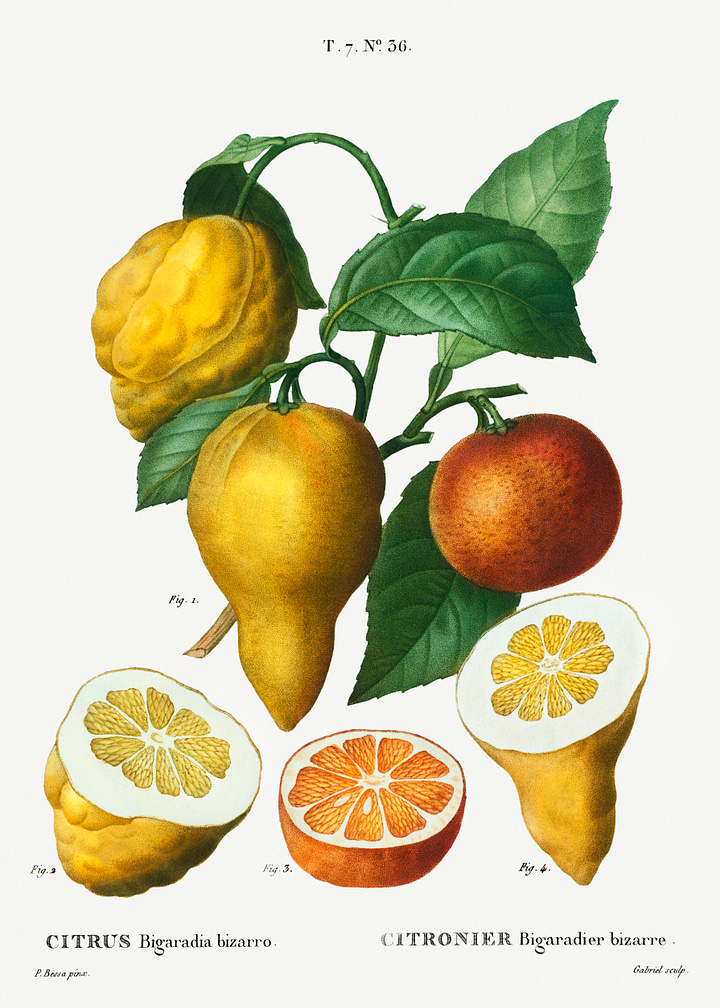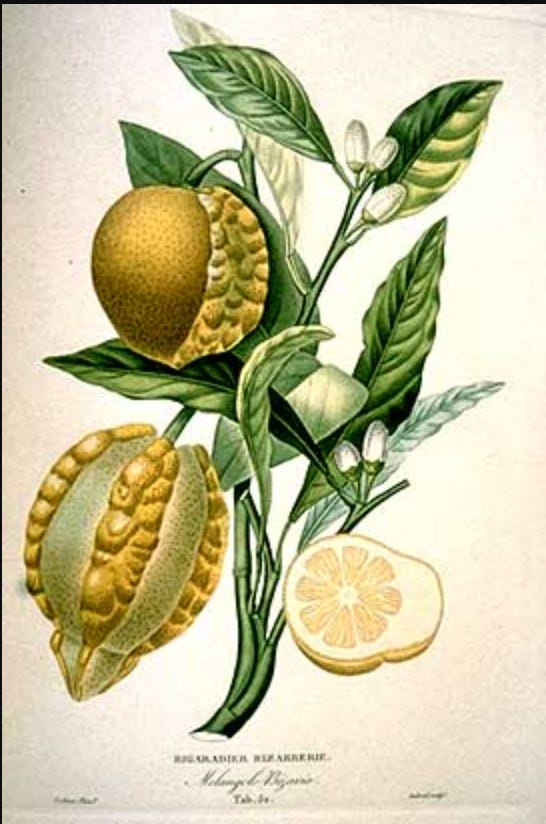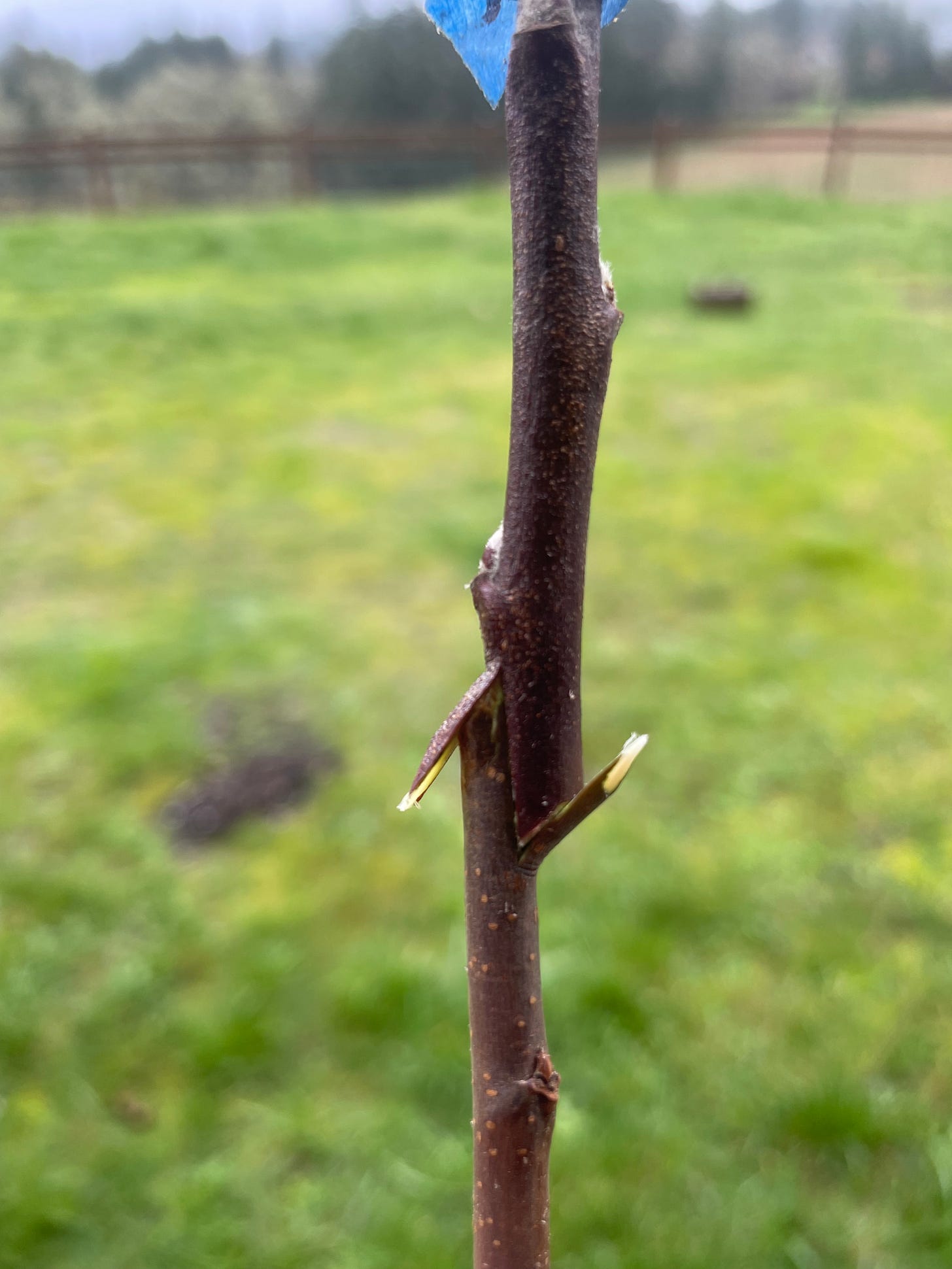Natural Magic: How to Lie to Plants and Get Away With It
The art and science of grafting fruit trees.
Practice resurrection.
— Wendell Berry, Manifesto: The Mad Farmer Liberation Front
I.
If you were lucky enough to sit next to Giambattista della Porta at a Neapolitan dinner party in the late 1500s, you'd likely spend the evening rollicking between genuine fascination and the creeping fear that he was experimenting on you. Picture it: you’re enjoying a respectable plate of roast squab and suddenly he leans in and begins laying out his methods for breeding lapdogs and how to improve the yield of your olive trees, with alarming enthusiasm.1 Without missing a beat he presses a goblet into your hands of a health tonic he concocted by washing a turtle in wine.2 Before you can discreetly pour it into a potted plant, he whispers that the pompous cardinal across the table will soon be unable to swallow (temporarily) thanks to the belladonna-laced wine he served him. For science and for laughs.
This was della Porta — equal parts scientific pioneer, Renaissance Martha Stewart, and pre-internet troll. His masterwork began as four volumes in 1558 and expanded over three decades into a twenty-one book encyclopedia of everything from optics to alchemy to food preservation to correcting the ill-scent of armpits to disguising yourself by dyeing your skin as black as an Ethiopian with walnut hulls and pomegranate.3 He had the unique ability to display a jarring combination of brilliant insight and spectacular bullshit, often on the same page. His cryptography work was groundbreaking enough to attract the Inquisition's attention. He developed precursors to the camera obscura that Kepler would later cite. And in the very same work, he offers methods for causing a woman's face to erupt in pimples by slipping her wine containing dead lizards. He helpfully notes this technique is used to disfigure whores.
His work marches through the world with taxonomical zeal and gleeful disregard for ethical boundaries: the chapter on cookery begins sensibly with How flesh may be made tender, accelerates through How Animals may be boiled, roasted, and baked, all at once, and culminates in instructions for chemically incapacitating unwanted dinner guests with his belladonna trick (How to drive Parasites and Flatterers from great mens tables).
And it will be as good sport, if you like not your guest, he assures us. Renaissance hospitality evidently came with certain risks. But nowhere did della Porta's blend of practicality and creative fiction express itself more vividly than in his writings on plants — particularly on the art of grafting.4
II.
I first learned of grafting a decade ago from my brother-in-law, then an earnest seventeen-year-old into permaculture and not yet the practical joker he’d grow to become. I still thought he was messing with me at first — when you first hear it, the idea that you can convince a plum tree to grow cherries sounds absurd (or peaches, nectarines, apricots, or almonds, or all of them on the same tree)5.
At its core, grafting involves persuading one tree to adopt another's branch as its own. The trick underlies nearly every orchard in the world. Your grocery store Honeycrisp apple, your easy to crack English walnuts, the Kalamata olives on your charcuterie board — they were all plucked from trees with split ancestry: roots chosen for disease resistance or size control paired with branches selected purely for fruit quality. Without this peculiar manipulation, treasured fruit varieties would exist only as fleeting moments.
The process is disarmingly simple. Cut a dormant branch from one tree (the scion), slice open another (the rootstock), insert the foreign wood, and seal the wound. Despite centuries of conjecture and experimentation, the practice itself hasn't changed much since Aristotle’s student Theophrastus documented it. While he bound the wound with layers of bark, mud, and hair, and today we use rubber bands and parafilm, the principles remain the same: keep your knife sharp, make sure the connection is snug, and preserve the moisture. What has changed is our understanding of compatibility — you can usually join plants of the same genus, occasionally the same family, and effectively nothing beyond that biological boundary.
Grafting has always been accompanied by a touch of the esoteric, occupying the borderland between botanical pragmatism and agricultural sorcery. Medieval herbalists recommended soaking apple scions in pike's blood to produce red-fleshed fruit. For stoneless cherries, they prescribed drawing an iron through the heart and marrow of the stock, then anointing with ox dung.6 Maimonides recorded an ancient ritual that required the scion to be held by a beautiful damsel, whilst a male person has disgraceful sexual intercourse with her — an odd combo of botanical and human fertility that speaks to grafting's significance as a kind of reproductive alchemy.7
Nature's own tricks added to the mystery. In rare cases, cells from both rootstock and scion spontaneously fuse at the graft union, creating genuine genetic mosaics that defy botanical norms. True graft chimeras blurred the lines of what was possible, like the Bizzarria orange that appeared in Florence in 1644. A fusion of citron and sour orange that produced fruits with distinct wedges of each parent, it sounds like something della Porta might have invented as a hoax. Because, despite his empirical bent, the man couldn't resist repeating Pliny and Virgil's wilder claims about grafting mulberries onto poplars or apples onto oaks. He famously declared the pomegranate like to a common whore, ready and willing for all comers in its supposed acceptance of any wayward branch.




Della Porta fittingly called his work Natural Magick. Archaic now, in his time natural magic encompassed everything from astrology and alchemy to botany and chemistry. It was empirical science, but blended with myth and enchantment. I think we need more of it in the modern world. For me, grafting still exists in that liminal space — explicable in theory yet still miraculous.
III.
Beneath the rough bark of trees runs a hidden river, a thin stream of potential energy called the cambium. This pale green waterway is the tree’s fountain of youth — it slowly builds sapwood on the inside and bark on the outside, year after year forming the rings where time writes itself into the wood. It is both chronicler and creator, an unbroken testament to survival through storms and floods, brutal winters and scorching summers.
When you take a knife to the wood of a scion and that of its host and fit the puzzle pieces together, the severed cambiums lie exposed and vulnerable. Cells begin dying at the edges of the wound, forming a callus — undifferentiated cells that interlock and mingle in the dark if the bond is tight and they recognize each other. The greater their surface area of contact, the more likely their union will hold. After some time their their vascular systems merge. Water rises up from foreign roots and the boundaries between selves dissolve.
It is one tree now, a marriage of opposites, siamese twins with distinct identities. The rootstock provides the patient strength, the ability to weather drought and disease, as well as its limits to growth, programmed to grow to a manageable orchard height. The scion contributes the character of the fruit, its particular sweetness or tartness, the blush of its skin, its rough russeting pattern.
Together they form something neither could be alone — a collaboration between wild and domestic, between the nearly forgotten cider apple rescued from an abandoned homestead and the carefully bred dwarfing rootstock designed for high-density orchards. Neither yields its essential nature. Together they become something new.
IV.
Every spring now I look forward to the time when lilac buds start to break, when the osoberries drip with tiny white flowers and plum and cherry blossoms explode in a cacophony of their own. It signals that apple trees hover on the perfect point between dormancy and awakening. This has become my ritual — buy rootstock, collect scionwood from the most interesting cider apple varieties I can find, bind them together, and hope.
I've gone through six seasons of grafting now. For the first couple years my success rate was fairly miserable, like some zealous Civil War surgeon sawing away. I tried everything from the basic cleft graft to the whip and tongue to those cheap scissor-like tools that supposedly cut the scion and rootstock into perfectly matched halves of a saddle. After much trial and error, I've settled on the z-graft. While it’s more commonly used for citrus, it’s become my go-to technique, and I've become confident enough to read the patterns of what will take and what won't.
I've averaged around thirty trees for the past three years, slowly accumulating a menagerie of black plastic pots that form a mobile nursery as we search for land to plant them. One day they will be the first bearers of a riotous cider orchard — an amalgamation of the oldest, the tastiest, the oddest, and the nameless legendary local varieties I can find.
More than any other garden activity, the first bud that breaks at the top of a successful graft gives me an incredible rush. It seems unreal that it actually works — watching a sliver of wood resurrect and thrive on an alien body still feels like witnessing something that shouldn't quite be possible. Grafting is simultaneously among the most unnatural and most essential acts in our long relationship with domesticated plants. It is both technical skill and an act of faith. It can preserve diversity or reduce it to monoculture, depending on how it's wielded.
And like all natural magic, it works whether you believe in it or not.
Varieties I’ve grafted this year
Ashmead’s Kernel
Black Oxford
Harrison
Frequin Rouge
Roxbury Russet
Néhou
Airlie Red Flesh
Esopus Spitzenburg
Niedwetzkyana
Newtown Pippin
Harry Masters Jersey
Porter’s Perfection
Médaille d'Or
Golden Russet
Almata Red flesh
Noël des Champs
Karmijn de Sonnaville
Red Tolman Sweet
From Natural Magick, Book 2: Of the generation of animals. Chapter: How to generate pretty little dogs to play with. He follows that with How to bring forth diverse kinds of Mules, How to generate Hawks of diverse properties, and How we may produce new and Strange Monsters… He also wrote a separate book on growing and breeding olive trees.
From Natural Magick, Book 4: Of Increasing Household-Stuff. Chapter: To make men drunk, and to make them loath wine.
From Natural Magick, Book 20: The Chaos. Chapter: How one may so alter his face that not so much as his friends shall know him.
Such as are taken prisoner, or shut up close and desire to escape, and such as do business for great men, as spies, and others that would not be known, it is of great moment for them to know how to change their countenances. I will teach them to do it so exactly, that their friends and wives shall not know them. Great men do not a little enquire about such secrets, because those that can dissemble their own persons, have done great matters, and lovers have served their mistresses, and parents have not suspected it.
These are all from the genus Prunus, which are all compatible with each other.
For more on this and an in depth history of grafting, see Ken Mudge’s paper A History of Grafting.
From his book, Guide to the Perplexed.
When a tree is grafted into another in the time of a certain conjunction of sun and moon, and incense is burned whilst a formula is uttered, that tree will allegedly produce something that will be exceedingly useful. The most remarkable witchcraft, as described in The Nabatean Book of Agriculture [Ibn-Whashiya’s tenth century treatise] was the grafting of an olive branch on a citron tree.. . .They also said that when one species is grafted upon another, the branch which is to be grafted must be in the hand of a beautiful damsel, whilst a male person has disgraceful sexual intercourse with her: during that intercourse the woman grafts the branch into the tree.
(Friedlander 1904)







